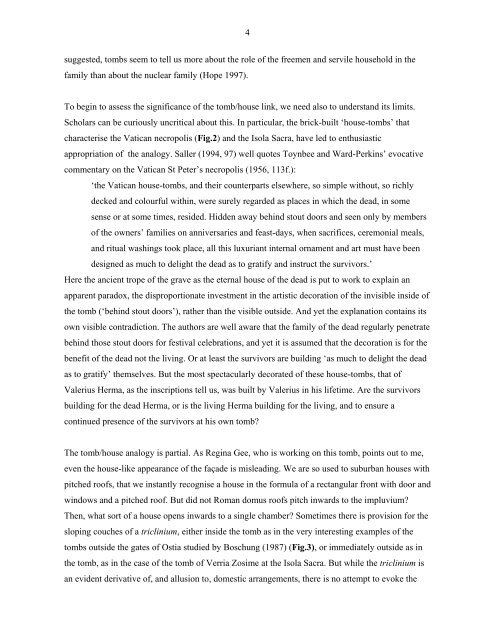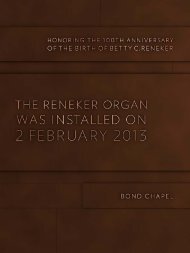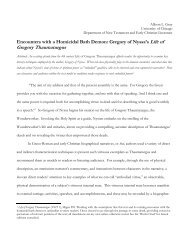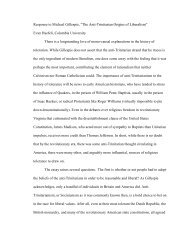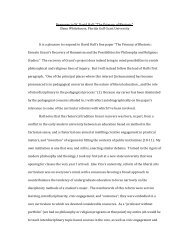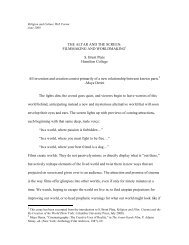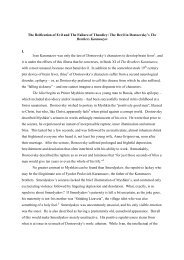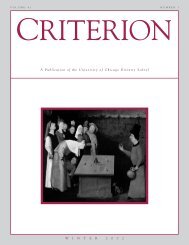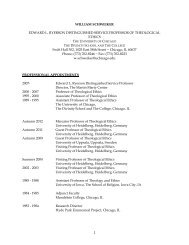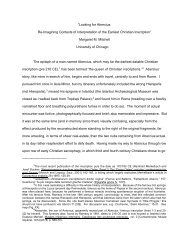Housing the Dead: the tomb as house in Roman Italy - Divinity School
Housing the Dead: the tomb as house in Roman Italy - Divinity School
Housing the Dead: the tomb as house in Roman Italy - Divinity School
You also want an ePaper? Increase the reach of your titles
YUMPU automatically turns print PDFs into web optimized ePapers that Google loves.
suggested, <strong>tomb</strong>s seem to tell us more about <strong>the</strong> role of <strong>the</strong> freemen and servile <strong>house</strong>hold <strong>in</strong> <strong>the</strong><br />
family than about <strong>the</strong> nuclear family (Hope 1997).<br />
4<br />
To beg<strong>in</strong> to <strong>as</strong>sess <strong>the</strong> significance of <strong>the</strong> <strong>tomb</strong>/<strong>house</strong> l<strong>in</strong>k, we need also to understand its limits.<br />
Scholars can be curiously uncritical about this. In particular, <strong>the</strong> brick-built ‘<strong>house</strong>-<strong>tomb</strong>s’ that<br />
characterise <strong>the</strong> Vatican necropolis (Fig.2) and <strong>the</strong> Isola Sacra, have led to enthusi<strong>as</strong>tic<br />
appropriation of <strong>the</strong> analogy. Saller (1994, 97) well quotes Toynbee and Ward-Perk<strong>in</strong>s’ evocative<br />
commentary on <strong>the</strong> Vatican St Peter’s necropolis (1956, 113f.):<br />
‘<strong>the</strong> Vatican <strong>house</strong>-<strong>tomb</strong>s, and <strong>the</strong>ir counterparts elsewhere, so simple without, so richly<br />
decked and colourful with<strong>in</strong>, were surely regarded <strong>as</strong> places <strong>in</strong> which <strong>the</strong> dead, <strong>in</strong> some<br />
sense or at some times, resided. Hidden away beh<strong>in</strong>d stout doors and seen only by members<br />
of <strong>the</strong> owners’ families on anniversaries and fe<strong>as</strong>t-days, when sacrifices, ceremonial meals,<br />
and ritual w<strong>as</strong>h<strong>in</strong>gs took place, all this luxuriant <strong>in</strong>ternal ornament and art must have been<br />
designed <strong>as</strong> much to delight <strong>the</strong> dead <strong>as</strong> to gratify and <strong>in</strong>struct <strong>the</strong> survivors.’<br />
Here <strong>the</strong> ancient trope of <strong>the</strong> grave <strong>as</strong> <strong>the</strong> eternal <strong>house</strong> of <strong>the</strong> dead is put to work to expla<strong>in</strong> an<br />
apparent paradox, <strong>the</strong> disproportionate <strong>in</strong>vestment <strong>in</strong> <strong>the</strong> artistic decoration of <strong>the</strong> <strong>in</strong>visible <strong>in</strong>side of<br />
<strong>the</strong> <strong>tomb</strong> (‘beh<strong>in</strong>d stout doors’), ra<strong>the</strong>r than <strong>the</strong> visible outside. And yet <strong>the</strong> explanation conta<strong>in</strong>s its<br />
own visible contradiction. The authors are well aware that <strong>the</strong> family of <strong>the</strong> dead regularly penetrate<br />
beh<strong>in</strong>d those stout doors for festival celebrations, and yet it is <strong>as</strong>sumed that <strong>the</strong> decoration is for <strong>the</strong><br />
benefit of <strong>the</strong> dead not <strong>the</strong> liv<strong>in</strong>g. Or at le<strong>as</strong>t <strong>the</strong> survivors are build<strong>in</strong>g ‘<strong>as</strong> much to delight <strong>the</strong> dead<br />
<strong>as</strong> to gratify’ <strong>the</strong>mselves. But <strong>the</strong> most spectacularly decorated of <strong>the</strong>se <strong>house</strong>-<strong>tomb</strong>s, that of<br />
Valerius Herma, <strong>as</strong> <strong>the</strong> <strong>in</strong>scriptions tell us, w<strong>as</strong> built by Valerius <strong>in</strong> his lifetime. Are <strong>the</strong> survivors<br />
build<strong>in</strong>g for <strong>the</strong> dead Herma, or is <strong>the</strong> liv<strong>in</strong>g Herma build<strong>in</strong>g for <strong>the</strong> liv<strong>in</strong>g, and to ensure a<br />
cont<strong>in</strong>ued presence of <strong>the</strong> survivors at his own <strong>tomb</strong>?<br />
The <strong>tomb</strong>/<strong>house</strong> analogy is partial. As Reg<strong>in</strong>a Gee, who is work<strong>in</strong>g on this <strong>tomb</strong>, po<strong>in</strong>ts out to me,<br />
even <strong>the</strong> <strong>house</strong>-like appearance of <strong>the</strong> façade is mislead<strong>in</strong>g. We are so used to suburban <strong>house</strong>s with<br />
pitched roofs, that we <strong>in</strong>stantly recognise a <strong>house</strong> <strong>in</strong> <strong>the</strong> formula of a rectangular front with door and<br />
w<strong>in</strong>dows and a pitched roof. But did not <strong>Roman</strong> domus roofs pitch <strong>in</strong>wards to <strong>the</strong> impluvium?<br />
Then, what sort of a <strong>house</strong> opens <strong>in</strong>wards to a s<strong>in</strong>gle chamber? Sometimes <strong>the</strong>re is provision for <strong>the</strong><br />
slop<strong>in</strong>g couches of a tricl<strong>in</strong>ium, ei<strong>the</strong>r <strong>in</strong>side <strong>the</strong> <strong>tomb</strong> <strong>as</strong> <strong>in</strong> <strong>the</strong> very <strong>in</strong>terest<strong>in</strong>g examples of <strong>the</strong><br />
<strong>tomb</strong>s outside <strong>the</strong> gates of Ostia studied by Boschung (1987) (Fig.3), or immediately outside <strong>as</strong> <strong>in</strong><br />
<strong>the</strong> <strong>tomb</strong>, <strong>as</strong> <strong>in</strong> <strong>the</strong> c<strong>as</strong>e of <strong>the</strong> <strong>tomb</strong> of Verria Zosime at <strong>the</strong> Isola Sacra. But while <strong>the</strong> tricl<strong>in</strong>ium is<br />
an evident derivative of, and allusion to, domestic arrangements, <strong>the</strong>re is no attempt to evoke <strong>the</strong>


